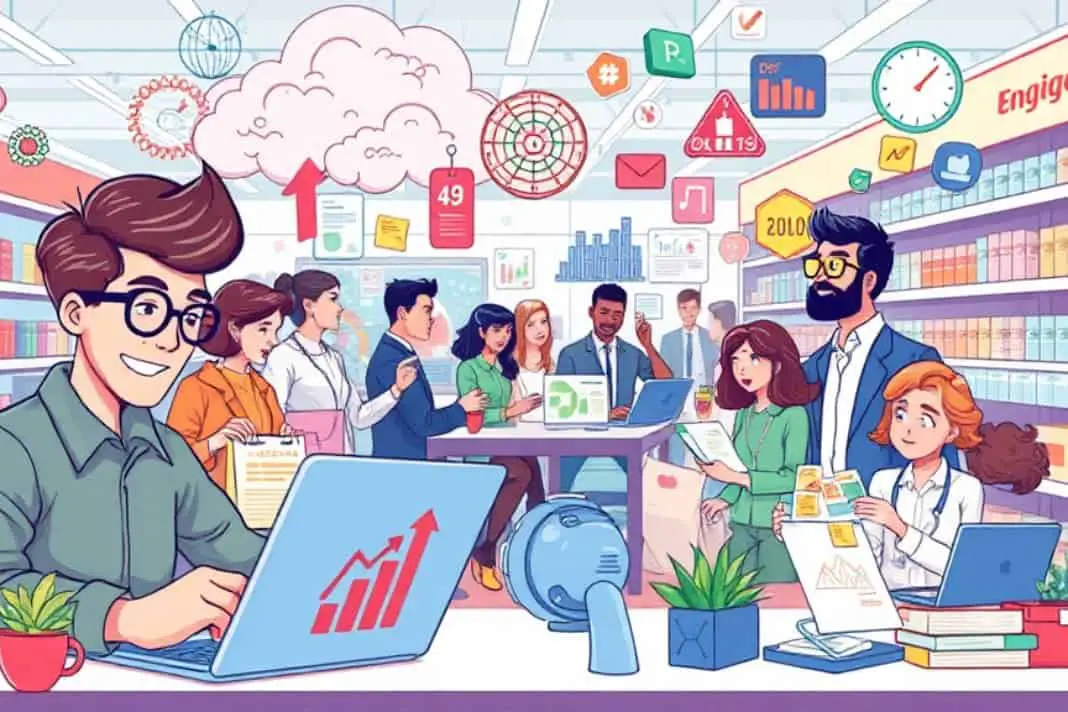Trade marketers struggle to optimize promotions without good insights. Big data offers a solution. It helps companies understand customers better, target the right groups and create more effective campaigns.
A McKinsey study shows companies using big data in marketing see 15-20% higher ROI than those using old methods. This shows how powerful data-driven approaches can be.
Key Takeaways
- Predictive models help forecast trends and improve retailer relationships
- Real-time data lets brands adjust promotions instantly at the point of sale
- Big data powers seamless customer experiences across all channels
- Ethical data use and privacy protection are vital for customer trust
- Data-driven marketing outperforms traditional methods in ROI and efficiency
Understanding Big Data in Trade Marketing
Big data in trade marketing means using huge amounts of information from digital interactions, sales, and communications.
This data helps marketers understand customer behaviour, market trends, and competitors.
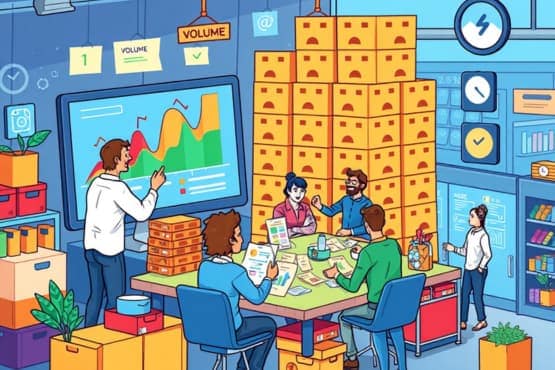
The Four V’s of Big Data in Practice
- Volume: Store systems track tons of inventory data daily. This helps avoid running out of stock or having too much.
- Velocity: Real-time data from cash registers lets marketers change promotions quickly when customer behaviour shifts.
- Variety: Social media posts and customer service calls add rich details to sales data.
- Veracity: Checking data from multiple sources (like loyalty programs and social media) ensures accuracy and reliability.
Benefits of Data-Driven Trade Marketing
Better Decision-Making
Data helps marketers make choices based on facts, not guesses. Procter & Gamble uses a system that analyzes billions of customer interactions to tailor product launches and marketing.
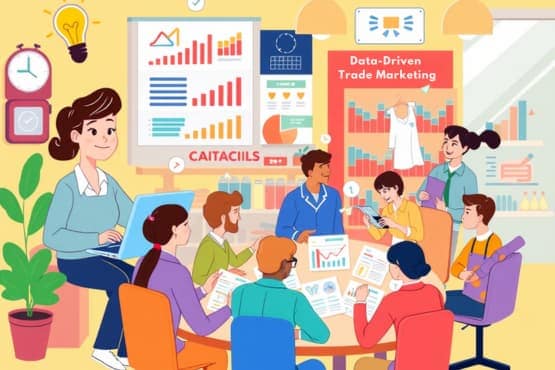
Improved Customer Engagement
Data lets companies personalize experiences. Boots, a UK retailer, saw 70% more people open their emails after using data to personalize loyalty program messages.
Smarter Resource Use
Predictive analytics help forecast trends and use resources better. Nestlé uses machine learning to predict product demand, cutting waste by 30% and stocking shelves.
Data Collection Methods in Trade Marketing
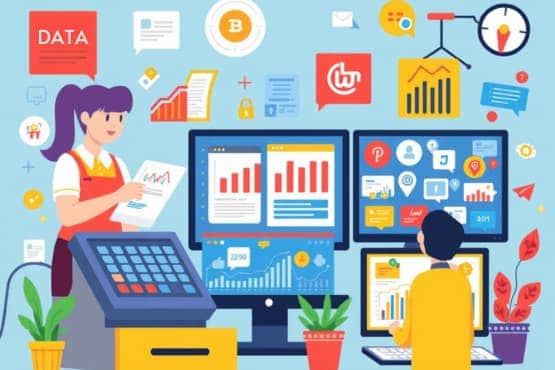
Cash Register Systems
Modern cash registers collect data on what’s selling, when, and how much. 7-Eleven uses its app to gather this data and offer personalized deals in real time.
Loyalty Programs
These programs track individual customer likes and habits. The North Face’s program helps them create targeted campaigns that have increased customer value by 25%.
Social Media Listening
Analyzing social media helps understand customer opinions and new trends. Unilever uses tools to track brand conversations and quickly adjust their strategies.
Mobile Apps and Location Data
Apps track user behaviour and location, helping with local marketing. Starbucks uses app data to offer personalized deals and improve menus based on regional tastes.
Advanced-Data Analysis Techniques
Predicting Promotion Success
Analyzing past data helps forecast how well promotions will work. Kellogg’s uses this to improve their promotions, increasing sales by 6%.
To start small with predictive analytics:
- Identify a specific business problem (e.g., forecasting demand for a product line)
- Gather relevant historical data
- Use simple tools like Excel or Google Sheets for initial analysis
- Look for patterns and trends
- Test predictions against actual results
- Gradually expand to more complex tools as you gain confidence
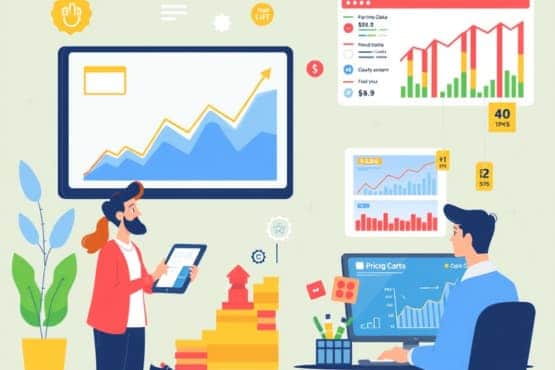
AI-Powered Customer Grouping
AI helps group customers more effectively than old methods. It looks at behaviour and preferences, not just age or location. L’Oréal uses this for product recommendations, boosting online sales by 35%.
Mid-sized companies can start with AI by:
- Using pre-built AI tools in existing marketing platforms
- Focusing on one area, like email personalization or product recommendations
- Partnering with AI startups that offer specific retail solutions
- Training a small team to understand and implement AI initiatives
Dynamic Pricing
This means changing prices in real time based on demand, competition, and stock levels. Best Buy does this to improve profits. It involves:
- Collecting market data in real-time
- Analyzing past sales
- Following business rules
- Using AI to optimize prices
- Updating prices automatically
Challenges include keeping prices fair and consistent across different sales channels.
Ethical Data Use and Privacy
Customers worry about their data being misused. Marketers must follow laws like GDPR and CCPA, but ethical data use goes beyond legal compliance.
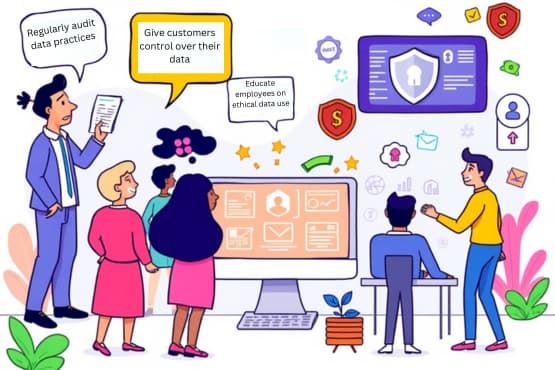
To build trust through ethical data practices:
- Be transparent about data collection and use
- Give customers control over their data
- Use data only for its intended purpose
- Implement strong data security measures
- Regularly audit data practices
- Educate employees on ethical data use
- Consider the societal impact of data-driven decisions
Example: Unilever lets customers manage their data preferences for all its brands and explains how data improves their products and services.
Breaking privacy rules or misusing data can lead to fines, lawsuits, and a damaged reputation. More importantly, it erodes customer trust, which is hard to rebuild.
Omnichannel Strategies with Big Data
Big data enables seamless customer experiences across online and offline platforms. This creates a consistent brand experience and improves customer satisfaction.
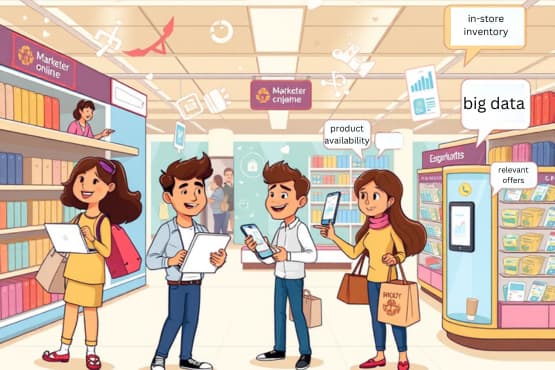
Case Study: Target uses big data to create a unified shopping experience:
- They track customer behaviour across their app, website, and in-store visits
- This data helps personalize product recommendations both online and in-store
- Their app shows in-store inventory, letting customers check product availability before visiting
- They use location data to send relevant offers when customers are near a store
- Customer service reps have access to purchase history across all channels, improving support
Result: Target saw a 10% increase in overall sales after implementing this omnichannel strategy.
Challenges and Solutions
Data Quality and Integration
Poor or disconnected data leads to bad decisions.
Solution: Use tools to clean data and create a central data system. Coca-Cola combines data from over 200 sources for better insights.
Lack of Skills
Many companies don’t have experts to use big data effectively.
Solution: Train staff or work with data experts. PepsiCo created a training program to teach their marketing teams about data tools.
Future Trends in Data-Driven Trade Marketing
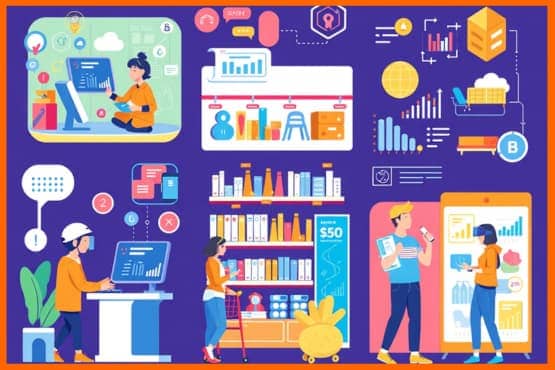
- AI and Machine Learning: These will make predictions and decisions smarter. Mars uses AI to place vending machines better.
- Internet of Things: Connected devices in stores will provide more detailed data. Walmart is testing smart shelves that track inventory in real time.
- Augmented Reality: AR will offer new ways to engage customers and gather data. IKEA’s AR app lets customers see furniture in their homes before buying.
- Blockchain: This could make product tracking more secure and transparent. Carrefour uses blockchain to track some food products, build trust, and provide marketing data.
Conclusion
Big data is transforming trade marketing. It helps companies create better campaigns, build stronger customer relationships, and stay ahead in the digital age. But it’s crucial to use data ethically and protect privacy.
To start using big data in your trade marketing:
- Assess your current data collection and analysis methods
- Identify areas where better data could improve your marketing
- Start small with a pilot project, like improving email personalization
- Invest in training your team or partner with data experts
- Choose tools that fit your needs and budget
- Always prioritize data privacy and ethical use
- Regularly review and update your data strategy
Remember, the goal is to use data to provide value to your customers, not just to your business. Focusing on customer needs and respecting privacy will build trust and loyalty in the long run.
Ready to take the next step? Consider consulting with a data analytics expert to evaluate your current marketing strategies and identify opportunities for data-driven improvements.

